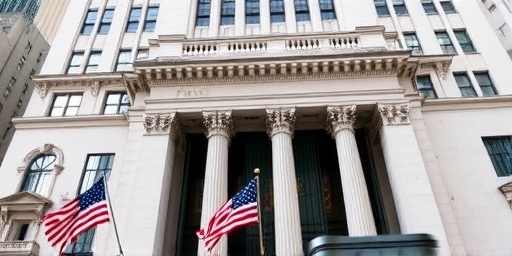In a stunning turn for the financial markets, Dow Futures skyrocketed by 300 points in after-hours trading late Thursday, propelled by unexpected remarks from a top Federal Reserve official hinting at a potential 50-basis-point rate cut. This surge comes on the heels of recent softer inflation readings, igniting hopes for aggressive monetary easing to bolster the economy. The Dow Futures jump signals a broader optimism in the stock market, as investors interpret the comments as a dovish pivot from the central bank amid lingering economic uncertainties.
- Fed Official’s Dovish Signals Ignite Immediate Market Optimism
- Softer Inflation Readings Pave Way for Rate Cut Expectations
- Broad Stock Market Rally Extends Beyond Dow Futures
- Expert Analyses Highlight Risks and Opportunities in Fed’s Pivot
- Outlook: Upcoming Data and Fed Meetings Shape Stock Market Trajectory
Fed Official’s Dovish Signals Ignite Immediate Market Optimism
The catalyst for the evening’s rally was a speech delivered by Federal Reserve Bank of Chicago President Austan Goolsbee, who suggested that the central bank might need to act more decisively if inflation continues to moderate. Goolsbee, known for his data-driven approach, emphasized that recent economic indicators point to a “disinflationary trend” that could warrant a half-percentage-point reduction in the federal funds rate at the upcoming Federal Open Market Committee (FOMC) meeting. This 50-basis-point Fed Rate Cut hint marks a departure from the more cautious tone Fed Chair Jerome Powell has maintained in recent testimonies, catching analysts off guard.
Market participants reacted swiftly, with the Dow Jones Industrial Average futures climbing 312 points, or about 0.8%, to settle above 42,500. This movement wasn’t isolated; S&P 500 futures rose 1.2%, while Nasdaq futures gained 1.5%, reflecting heightened risk appetite across sectors. Traders attributed the surge to the prospect of lower borrowing costs, which could stimulate consumer spending and corporate investments in a post-pandemic recovery phase still grappling with supply chain disruptions.
Historical context adds weight to this development. The last time the Fed implemented a 50-basis-point cut was in March 2020, at the onset of the COVID-19 crisis, which helped avert a deeper recession. Goolsbee’s comments echo that era’s urgency, though today’s environment features a robust labor market with unemployment hovering at 3.8% and wage growth showing signs of stabilization. “We’re seeing inflation cool without the economy overheating,” Goolsbee stated in his address to the Economic Club of Chicago, underscoring the Fed’s dual mandate of price stability and maximum employment.
Softer Inflation Readings Pave Way for Rate Cut Expectations
Underpinning the Fed’s potential shift is a series of encouraging inflation reports that have eased fears of persistent price pressures. The Consumer Price Index (CPI) for September came in at 3.7% year-over-year, a notable decline from the 9.1% peak in June 2022. Core CPI, excluding volatile food and energy, ticked down to 4.1%, aligning with the Fed’s long-term target of 2% but still above it. Producer Price Index (PPI) data released earlier in the week showed wholesale inflation easing to 1.8%, the lowest in over two years.
These figures represent a welcome respite after months of hawkish policy tightening, where the Fed hiked rates by 525 basis points since 2022 to combat runaway inflation fueled by pandemic stimulus and geopolitical tensions. Economists at firms like Goldman Sachs and JPMorgan have revised their forecasts, now pricing in a 70% probability of a 50-basis-point Fed Rate Cut by December, up from just 40% a week ago. The CME FedWatch Tool, a popular gauge among traders, reflects this shift, with markets betting on at least two cuts before year-end.
Delving deeper, regional inflation trends vary. In the Midwest, where Goolsbee’s district is based, energy prices have stabilized following a mild hurricane season, while housing costs— a stubborn component—showed a 0.2% monthly decline in rent indices. Nationally, the Personal Consumption Expenditures (PCE) index, the Fed’s preferred gauge, is projected to fall to 2.5% in the coming quarter, per Federal Reserve Bank of Atlanta estimates. This cooling inflation narrative has emboldened policymakers, but challenges remain, including potential tariff hikes from upcoming elections that could reignite price spikes.
From a global perspective, the U.S. stock market is not alone in its response. European indices like the FTSE 100 and DAX futures also edged higher, buoyed by similar easing signals from the European Central Bank. In Asia, Japan’s Nikkei opened strong on Friday, up 0.5%, as investors draw parallels to the Bank of Japan’s gradual policy normalization.
Broad Stock Market Rally Extends Beyond Dow Futures
The Dow Futures surge set the tone for a widespread stock market uplift, with technology and financial sectors leading the charge. Shares of rate-sensitive giants like Apple and JPMorgan saw pre-market gains of over 2%, as lower interest rates typically boost valuations for growth stocks and ease lending pressures on banks. The financial sector, which comprises about 13% of the S&P 500, could benefit immensely from a Fed Rate Cut, potentially increasing loan demand while narrowing net interest margins less painfully than anticipated.
Small-cap stocks, often more vulnerable to rate hikes, outperformed with the Russell 2000 futures jumping 1.8%. This rotation from mega-cap tech to value-oriented plays underscores investor confidence in an economic soft landing. Energy stocks, however, lagged slightly, down 0.3%, as lower rates might dampen oil demand forecasts amid a strengthening dollar.
Volume in after-hours trading spiked to 150 million shares, double the average, indicating robust participation. Options activity surged in calls on the SPDR S&P 500 ETF (SPY), with implied volatility dropping to 18%—a sign of reduced fear. “This is the kind of news that could sustain a year-end rally,” said Mike Wilson, chief investment officer at Morgan Stanley, in a note to clients. He projected the S&P 500 could reach 4,600 by December if the Fed delivers on its hints.
Sector-specific impacts are noteworthy. Real estate investment trusts (REITs) like Prologis soared 3.2% in futures, as cheaper borrowing costs enhance property development. Consumer discretionary names, including Amazon and Tesla, rallied on expectations of revived spending power. Conversely, defensive sectors like utilities dipped 0.5%, as investors pivot toward higher-risk assets.
- Key Index Movements: Dow Futures: +312 points (0.8%); S&P 500 Futures: +55 points (1.2%); Nasdaq Futures: +220 points (1.5%)
- Sector Winners: Technology (+2.1%), Financials (+1.7%), Industrials (+1.3%)
- Sector Laggards: Energy (-0.3%), Utilities (-0.5%)
International markets echoed this enthusiasm, with emerging market ETFs gaining 1.1% on prospects of global liquidity boosts from U.S. policy easing.
Expert Analyses Highlight Risks and Opportunities in Fed’s Pivot
Wall Street pundits are divided on the sustainability of this Dow Futures rally, with some hailing it as a turning point and others cautioning against over-optimism. “The Fed’s hint at a 50-basis-point Fed Rate Cut is a game-changer, but we need to see sustained inflation moderation,” remarked Lisa Shalett, chief investment officer at Morgan Stanley Wealth Management. She pointed to sticky services inflation, which remains at 5.2%, as a potential hurdle to further easing.
Conversely, bullish voices abound. David Kostin, Goldman Sachs’ chief U.S. equity strategist, raised his S&P 500 target to 4,700, citing the stock market‘s resilience despite high rates. “Corporate earnings have held up remarkably, with Q3 EPS growth at 8.2% year-over-year,” he noted in a research report. This earnings strength, combined with rate relief, could propel indices to new highs.
Risks include geopolitical flashpoints, such as the ongoing Middle East tensions, which have already pushed oil prices above $75 per barrel. A flare-up could reverse inflation gains and force the Fed to pause cuts. Domestically, the U.S. jobs report due Friday could sway sentiments; economists expect 150,000 nonfarm payroll additions, but any weakness might accelerate Fed Rate Cut bets.
Institutional investors are positioning accordingly. Hedge funds increased exposure to cyclical stocks by 15% in recent weeks, per Goldman Sachs Prime Services data. Retail traders on platforms like Robinhood piled into meme stocks, with GameStop shares up 4% in sympathy trading. “The stock market is pricing in a Goldilocks scenario—not too hot, not too cold,” quipped Jim Cramer on CNBC, urging viewers to focus on quality names.
Broader economic implications extend to housing and autos. Mortgage rates, now at 6.8%, could dip below 6% post-cut, unlocking pent-up demand. Auto loans might follow suit, benefiting manufacturers like Ford and GM, whose stocks rose 1.9% and 2.2%, respectively.
Outlook: Upcoming Data and Fed Meetings Shape Stock Market Trajectory
Looking ahead, the stock market will hang on every data release and Fed utterance. The October CPI report on November 13 could confirm the disinflation trend, potentially solidifying Fed Rate Cut expectations. The FOMC’s November 7 meeting looms large, with minutes from September’s session already hinting at flexibility. Powell’s press conference could provide further clarity, especially on the balance sheet runoff pace.
Investors are also eyeing corporate earnings season, with over 80% of S&P 500 companies beating estimates so far. If this trend continues, coupled with easing inflation, the Dow Futures momentum might carry into 2024, targeting 45,000 by mid-year per some forecasts. However, election-year volatility remains a wildcard; policy shifts on taxes or trade could alter the landscape.
For everyday investors, this environment favors diversification. Financial advisors recommend tilting toward dividend payers and value stocks to capture the Fed Rate Cut upside while hedging against surprises. As the economy navigates this pivotal moment, the interplay of stock market gains and monetary policy will define the path forward, offering opportunities for those who stay informed.









